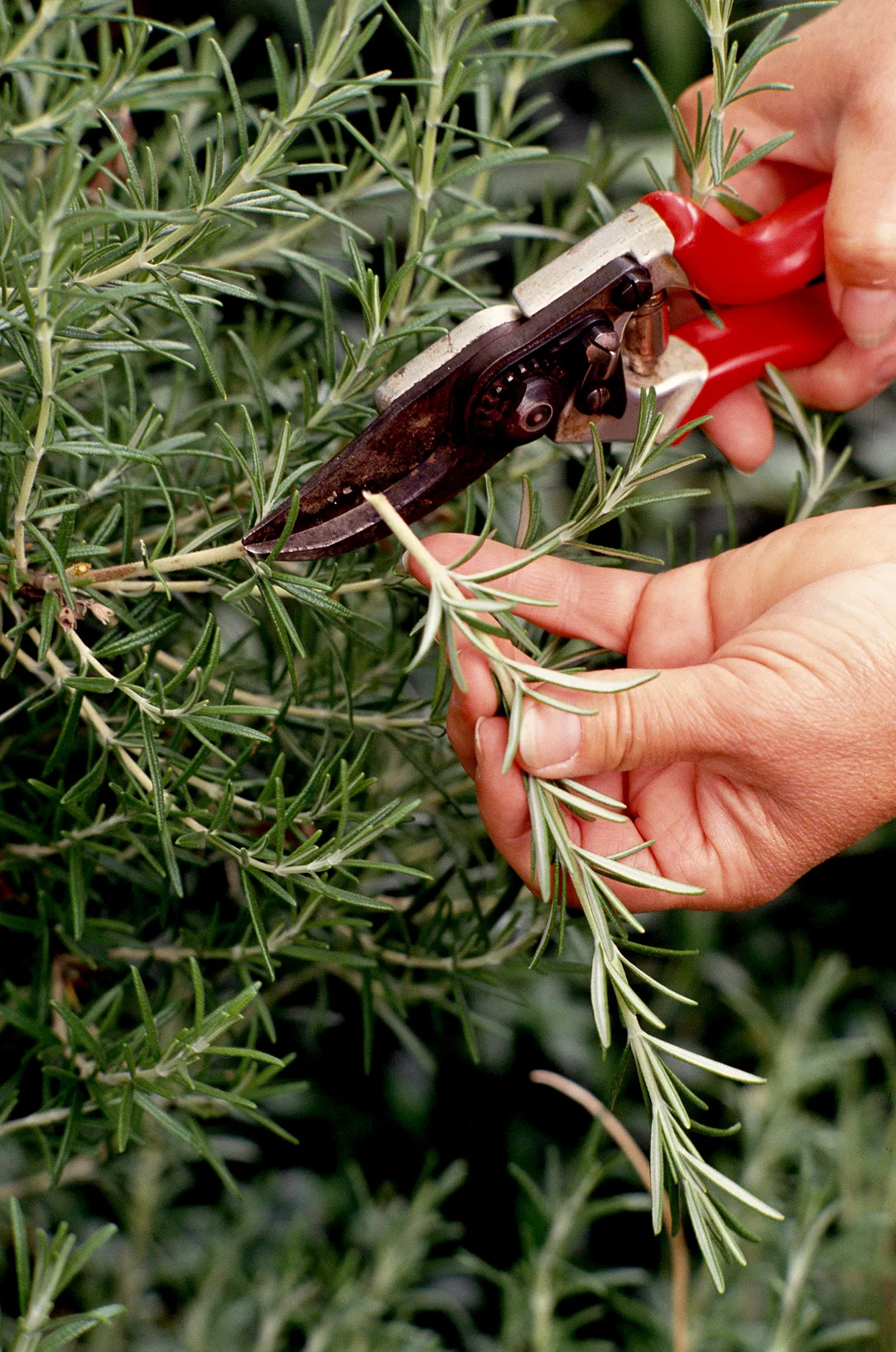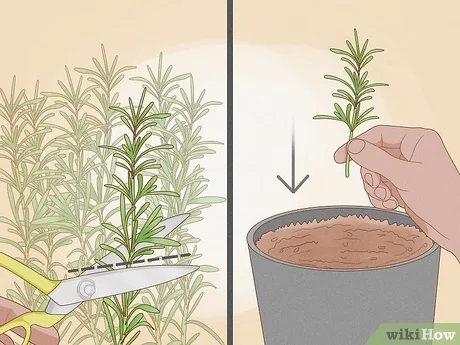Knowing when and how to prune rosemary will help you get the most out of this popular herb. Rosemary is often grown as an annual in cool climates, but it can grow as a perennial in warmer areas. With proper care, perennial rosemary plants can grow into large, 6-foot-tall shrubs that can live for more than 30 years. If you live where this herb comes back year after year, it’s especially important to prune rosemary regularly so you can prevent your plant from becoming woody or leggy. Use these tips and step-by-step guide to get started.

Why Prune Rosemary?
Like lavender, rosemary only produces leaves and flowers on new growth, and plants can become overgrown and woody or develop unsightly bald patches if they aren’t pruned regularly. Pruning rosemary at least once a year rejuvenates the plants and encourages them to produce more leaves and flowers. Plus, pruning gives you the opportunity to reshape rosemary plants into classic rounded topiaries, tidy hedges, and other creative forms.
Beyond this, pruning opens up the center of rosemary plants, increasing airflow and helping to prevent fungal diseases, like powdery mildew and botrytis. Of course, pruning rosemary is the best way to harvest lots of fresh rosemary for cooking and drying, and it also leaves you with cuttings that you can propagate into new plants for your garden.
When to Prune Rosemary
Rosemary should be pruned at least once a year, but you may need to prune it more often if you live in a warmer climate where rosemary grows rapidly. The best time to prune rosemary is in spring or early summer, immediately after the plant’s flowers begin to fade.
Rosemary can also be pruned later in the season, but don’t prune it too late in the year, as new growth needs some time to harden off before winter. If you prune rosemary in autumn, make sure you complete the pruning at least six weeks before your area’s first frost is expected.
While mature rosemary plants usually need the most pruning, it’s a good idea to start early and prune young plants during their first year. Young rosemary is easy to shape into new forms, and pruning young plants makes them much bushier.
How to Prune Young Rosemary Plants
Whether you’re growing rosemary as an annual herb or you purchased a new plant and want to shape it for optimal growth, pruning young plants is always a good idea. However, it’s more important to be precise when pruning young rosemary plants, as your pruning cuts form the foundation of the plant as it grows.
If you want to reshape young rosemary plants and encourage them to grow more stems for harvesting, prune the plants in spring to early summer by snipping away the tips of the stems and shaping your plant as you go. While young rosemary can be worked into many creative shapes and topiary forms, if you want the rosemary to grow in a classic, mounded shape, cut the stems a bit shorter toward the perimeter of the plant and allow them to grow longer at the plant’s center. Also, only cut the top 3 to 6 inches of your plant’s stems, and never cut into the plant’s woody growth. For a bushier look, pay attention to where you make the cuts and cut right above a set of leaves or nodes, which will cause your plant to branch out at that point.
Young, tender stems are easiest to propagate into new plants, so save a few cuttings to make more rosemary plants. Simply dip the cut end of the rosemary stems in rooting hormone and plant them in a rich, moist potting mix until they root.
If you want to harvest rosemary for eating, the tender stems are also the most flavorful, and you’ll get the best taste if you pick them right before they flower.
How to Prune Large Rosemary Plants in 6 Easy Steps
Large, mature, or overgrown rosemary plants usually require a bit more pruning than young ones, but the process shouldn’t take much time, and it’s a great way to improve your plant’s health and appearance.
1. Clean your tools.
Before making any cuts in your rosemary plants, always disinfect your tools. Plant diseases can easily spread during the pruning process, but you can prevent this by wiping down your tools in between plants with isopropyl alcohol. It’s also a good idea to sharpen your tools to ensure they make the cleanest cuts.
2. Inspect the plant.
Take a good look at your plant and notice where the newer, leafy stems end and the woody section of the plant begins. Like many other woody-stemmed herbs, rosemary will not produce leaves on old wood, so don’t prune into the woody sections of your plant, as these areas will usually not regrow.
3. Remove any broken or diseased stems.
Next, using pruners or loppers, snip away any damaged, diseased, or broken sections of your rosemary. If branches were damaged during winter, make your cuts below the damaged area. While you generally don’t want to cut into the woody sections of rosemary, old, dead growth, or woody stems that are growing into each other can be pruned away to open up the center of the plant and improve airflow.
4. Make the cuts.
After pruning back any damaged areas of the plant, begin pruning the actively growing rosemary stems by gathering them in one hand and cutting them back at a 45-degree angle with pruners, loppers, or shears. Work your way around the plant until your rosemary has been shaped as you want it.
As you work, be conscious that you don’t cut away more than one-third of the plant. Also, leave at least 3 to 4 inches between your cuts and where the woody section of the plant begins so you don’t accidentally create bald patches in the rosemary plant.
5. Shape the rosemary.
If you like the look of a rounded rosemary shrub, prune the stems a bit shorter around the plant’s perimeter. Rosemary can also be pruned into topiaries, hedges, or other unique shapes depending on your gardening style and pruning technique.
6. Repeat (if needed).
Often, rosemary plants need to be pruned only once a year, but plants that are growing vigorously may need to be pruned more frequently. Just remember that you should stop pruning rosemary at least six weeks before frost arrives so that new growth isn’t damaged by cold weather.
If you grow rosemary indoors as a houseplant, prune it in spring by making cuts with scissors or pruners just above a set of leaves on a stem. Remove dead stems when they occur.
Can Woody Rosemary Be Saved?
Pruning rosemary at least once a year prevents rosemary plants from becoming overgrown and woody. However, if you forgot to prune rosemary for several years or you’ve purchased a property with established rosemary plants, you may want to try your hand at salvaging a woody rosemary plant.
Unfortunately, when rosemary plants become woody, they’re hard to rejuvenate, so growers usually opt to replace the plants instead. However, with patience and care, you may be able to bring back an old rosemary plant. Just keep in mind this process isn’t always successful.

When you want to rejuvenate woody rosemary, it’s best to focus on one section of the plant at a time and then allow it to recover for several months before pruning the next section. When pruning old plants, cut the stems back just a few inches above where the woody part of the plant begins. Also, never remove more than one-half of the plant’s stems at once, as overly vigorous pruning can cause rosemary to stop growing.





